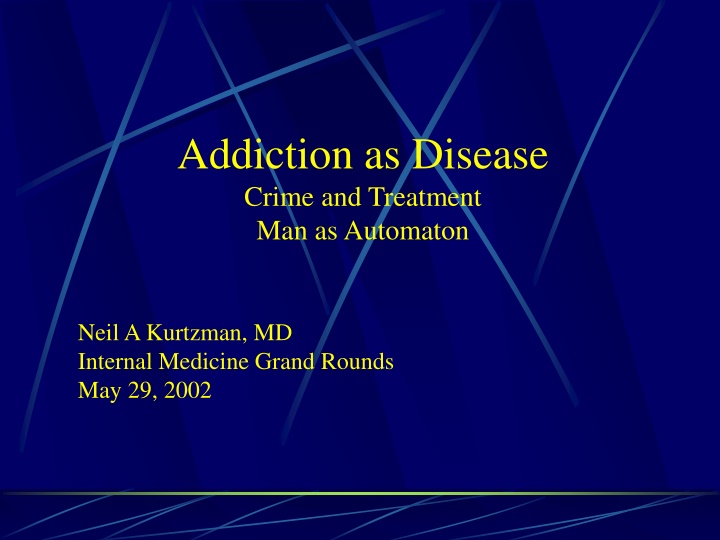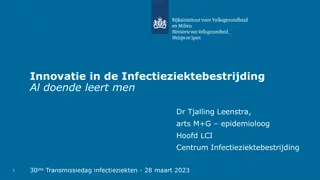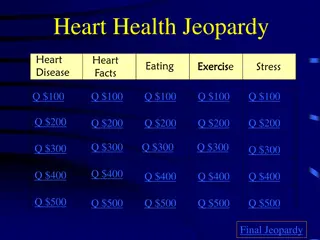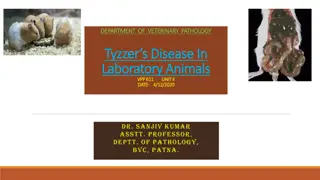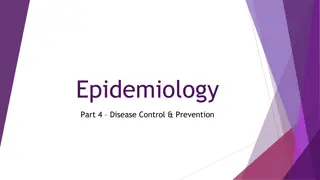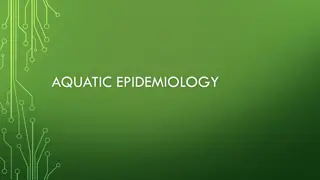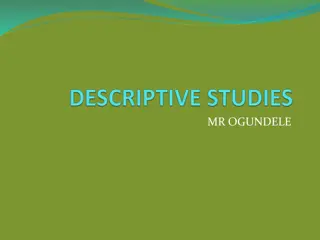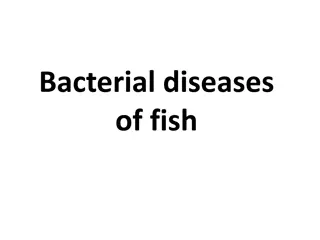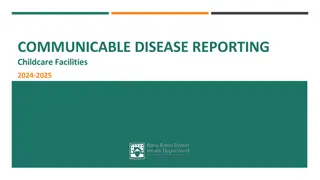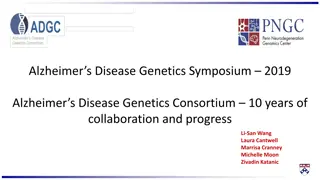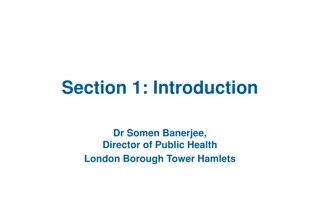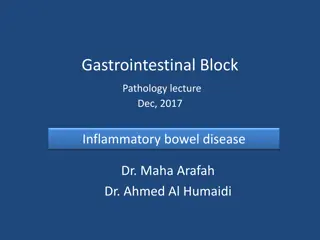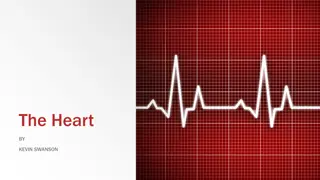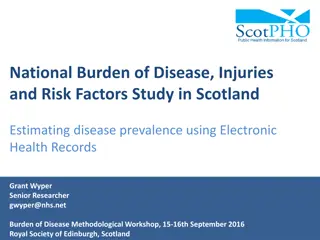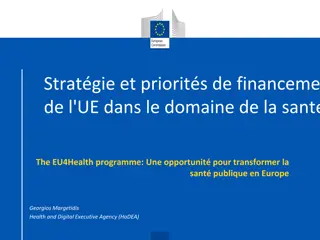Human Health and Disease
The concept of disease and its implications for human health are explored in this thought-provoking content. Different definitions of disease, the impact of voluntary acts on disease development, and the unique nature of mental illness are discussed. The complexity of defining disease and its relationship to individual responsibility are highlighted, questioning common perceptions and drawing attention to the broader implications of these discussions on society's outlook on health.
Download Presentation

Please find below an Image/Link to download the presentation.
The content on the website is provided AS IS for your information and personal use only. It may not be sold, licensed, or shared on other websites without obtaining consent from the author.If you encounter any issues during the download, it is possible that the publisher has removed the file from their server.
You are allowed to download the files provided on this website for personal or commercial use, subject to the condition that they are used lawfully. All files are the property of their respective owners.
The content on the website is provided AS IS for your information and personal use only. It may not be sold, licensed, or shared on other websites without obtaining consent from the author.
E N D
Presentation Transcript
Addiction as Disease Crime and Treatment Man as Automaton Neil A Kurtzman, MD Internal Medicine Grand Rounds May 29, 2002
Health is a state of complete physical, mental and social well-being and not merely the absence of disease or infirmity. Constitution of the World Health Organization
Disease: Any deviation from or interruption of the normal structure or function of a part, organ, or system of the body as manifested by characteristic symptoms and signs; the etiology, pathology, and prognosis may be known or unknown. Dorland s Medical Dictionary, 29thedition
Is it any wonder were confused with definitions like these? Notice that Disease says nothing about the deviation being harmful Homosexuality is a disease according to the above definition So is doing great mathematics to the exclusion of everything else, eg Ramanujan
Disease is a state that places individuals at increased risk of adverse consequences. Temple et al, Science 293:807, 2001 This definition includes not wearing your seat belt, joining the SEALs, and walking in the wrong part of town.
A disease has an exclusive pathogenesis; DM is always due to an absolute or relative deficiency of insulin It has the potential for harm It is never voluntary, though voluntary acts may cause disease. The voluntary act itself is not the disease All acts are voluntary until proven otherwise
Humans are held to be responsible for their acts Mental illness absolves the patient of responsibility for his acts Mental disease differs from all other illnesses because of volition
The influence of scientific patterns of thought on our general outlook has become extremely pervasive; and the overwhelming majority is today uncritically in thrall to more or less crude forms of scientism. Roger Hausheer, Introduction to Isaiah Berlin, The Proper Study of Mankind, 1997
Suppose I am an alcoholic, a slave to the bottle. Would I not wish to renounce part of my liberty that enslaves me to the bottle. (W)hat are we to do with the majority of mankind who are unable to master their sinful passions? -more-
Here, says Berlin, the real horror of a purely rational view of life unfolds. For if it can be shown that there is only one correct view of life, people who fail to follow it must be forced to do so. Noel Annan, Foreword to Isaiah Berlin, The Proper Study of Mankind, 1997
Negative liberty: The freedom to act without outside interference. It (is) easy for me to conceive of myself as coercing others for their own sake . Once I take this view I am in a position to ignore the actual wishes of men or societies, to bully, oppress, torture them in the name, and on behalf of their real selves. Berlin, Two Concepts of Liberty, 1958
Liberty is the absence of coercion. Coercion, however, cannot altogether be avoided because the only way to prevent it is by the threat of coercion. Free society has met this problem by conferring the monopoly of coercion on the state. Hayek, The Constitution of Liberty, 1960, p 21
Liberty and responsibility are inseparable. It (responsibility) often evokes the outright hostility of men who have been taught that it is nothing but circumstances over which they have no control that has determined their position in life or even their actions. Hayek, p 72
It is doubtful that democracy could survive in a society organized on the principle of therapy rather than judgement, error rather than sin. If men are free and equal, they must be judged rather than hospitalized. FD Wormuth The Origins of Modern Constitutionalism, 1949
At present there is no reliable evidence from large randomised trials to support screening mammography programmes. Richard Horton, The Lancet 358:1284, 2001 There is no reliable evidence that screening for breast cancer reduces mortality. Gotzche and Olsen, Lancet 355:129, 2000
In medicine we never abandon a futile treatment until an effective one appears. Thus, I m convinced we will persist in our costly and ineffective diagnostic and therapeutic campaign against breast cancer until someone comes up with something that really works. -more-
Then everyone will admit that what we are now doing never worked and will wonder how we could have persisted for so long when it so obviously was a failure. In the meanwhile, the expenditure of emotional energy will exact a greater price than dollars spent for no discernible end. Kurtzman, Am J Kidney Dis 35:327, 2000
Opium alone stands the test of experience as a remedy capable of limiting the progress of the disease (Diabetes Mellitus). Osler, The Principles and Practice of Medicine, 1892, p 304
Medicine is not a science The therapeutic imperative overwhelms everything, including Primum non nocere WP
Our attitudes towards addiction are exactly what you would expect from simultaneously loosing thousands of lawyers and psychiatrists on the same problem.
Alcoholism as a disease is no more than 200 years old, though it has been used for thousands of years Levine, J Stud Alcohol 39:143, 1978 Alcoholism as a disease which only affects a small group of biologically predestined individuals is less than 70 years old Peele, J Psychoactive Drugs 20:375, 1988
Alcohol and opiate use were much more common in the 19thcentury than now Both were criminalized in the 20thcentury and then medicalized Addiction is now defined as an illness because doctors have categorized it thus Berridge & Edwards, Opium and the People, Yale Univ Press, 1987, p 130
Homosexuality is no longer defined as an illness because doctors no longer categorize it as such.
DSM IV devotes 98 pages to Substance Abuse Mental Health: A Report of the Surgeon General, 1999 barely mentions it
Although addictive disorders are included as mental disorders in the DSM classification system, they are distinguished from all other mental disorders in the Surgeon General s Report.
Drinking problems are virtually unknown in most of the world s cultures. Solitary, addictive drinking behavior does not occur to any significant extent in small-scale traditional societies. Heath, Encyclopedic Handbook of Alcoholism, 1982, p 426 Beverage alcohol is usually not a problem in a society unless it is defined as such Marshall, Beliefs, Behaviors, and Alcoholic Beverages, 1979, p 451
Bad driving could just as readily be considered a disease by those who think alcoholism a disease It kills thousands of people It is, however, voluntary and has many causes It s amenable to intervention You can teach some people to be better drivers One could look for genetic markers for bad driving
Cocaine and opium were commonly used in 19thcentury patent medicines Godfrey s Cordial, which contained opium, was given to quiet Victorian babies
Of all men addicted to heroin in Viet Nam, only 12 % relapsed to addiction after their return Of those addicted in the first year back, half were treated and half were not 47% of those treated had a second relapse 17% of those not treated had a second relapse Robbins, et al, Yearbook of Substance Abuse, 2:213, 1980
Half of those addicted to heroin in Viet Nam used it after returning to the US Only one-eighth became readdicted Heroin use led to addiction no more often than did amphetamine or marijuana use Robbins, et al
Animals in spacious cages shared with other rats vastly prefer water to narcotic solution even after having drunk the solution exclusively for weeks Animals that consume drugs and alcohol excessively when under extremely uncomfortable conditions cease when normal lab conditions are restored Falk, Pharacol Biochem Behav 19:385, 1983
Most animals cannot be made into addicts. In response to drugs regularly reported to addict humans animals generally avoid such drugs when given a choice. Dole, Sci Am:138, June 1983
Smoking is highly addictive Yet 36 million people have stopped without any treatment though tobacco is more addictive than cocaine (Fiore et al, JAMA 263: 2760, 1990) I can get almost anybody to stop instantly with four words
Addiction as a disease has a strong economic basis. Those who provide the care depend on this concept for their livelihood. This, at least in part, explains the persistence of expensive inpatient regimens for alcohol though every study has shown outpatient treatment to be at least as effective Miller and Hester, Am Psychol 41:794, 1986
Miller et al at the University of New Mexico evaluated 43 kinds of alcohol abuse treatment from 211 controlled trials. The treatment with by far the best score was brief intervention . Peele, The Sciences March/April 1998
The concept of addiction as disease has been used to explain almost every human failing and thus to absolve miscreants of responsibility for their bad acts. When Wade Boggs was caught in an illicit sexual relationship, he confessed to sex addiction. His former mistress said, I guess what I thought was love was just a disease.
Cocaine produces no gross physiological withdrawal symptoms (Gawin, Science, 251:1580, 1991; DSM IV, 1994 p 225) In 1990 the NIDA found that 11.5% of Americans had used cocaine, but only 0.9% in the last month; only 0.09% used it weekly (DHHS Publication # ADM 91-1732) The vast majority of cocaine users do not become chronic users
Cocaine-driven humans will relegate all other drives and pleasures to a minor role in their lives . If we were to design deliberately a chemical that would lock people into perpetual usage it would (be) cocaine (Cohen, US Govt Printing Off, 1984) Repeated doses of addictive drugs opiates, cocaine, and amphetamine cause drug dependence and afterward, withdrawal (Hyman, Science 273:611, 1996)
After 10 years, 60% (of cocaine users) had become completely abstinent, and 40% remained occasional users. Most drug users ultimately stop. Drugs no longer fit their lifestyle. They get jobs, they have to get up early, they stop going to the disco, they have kids. Peter Cohen, Centre for Drug Research, University of Amsterdam
Americans born before 1905 had a 1% rate of depression by age 75 Americans born 50 years later had a 6% rate of depression by age 24 In the 1960s the average age of onset for manic- depression was 32 In 1995 it was 19 Only social factors can explain the above Peele and DeGrandpre, Psychol Today July/Aug 1995, p 62
Antidepressants work They have cellular and biochemical effects But the gulf between the description of drug action (at the cellular and biochemical level) and the description at the functional and behavioral level remains very wide. Attempts to bridge it seem like throwing candy floss into the Grand Canyon. Rang et al quoted in Glynn The Anatomy of Thought, Oxford Univ Press, 1999, p 349
The Brain/Behavior Syllogism The brain controls behavior The brain is an organ Therefore, behavior can be understood by examining the biological mechanisms that are common to all organs
Compulsive drug-seeking behavior is often attributed to the seductive reinforcing of certain insidious drug molecules. Rather behavioral variables are as important as pharmacological ones in the development of compulsive drug-seeking behavior. Charles Schuster, Director, National Institute on Drug Abuse
The Molecular Psychiatrist Sir, a psychiatrist doing molecular biology is like a dog walking on his hind legs. It is not done well, but you are surprised to find it done at all. Apologies to Sam Johnson and James Boswell
Drugs of abuse cause long-lasting changes in the brain that underpin the behavioral abnormalities associated with drug addiction. Nestler, Science 292:2266, 2001
Numerous changes in the brain have been described in animals taking drugs of abuse The link between these changes and behavior is totally absent
Mice lacking the fosB gene show abnormal biochemical and behavioral responses to chronic administration of drugs of abuse or antidepressant treatments . This evolving work supports the view that delta fosB functions as a type of molecular switch that gradually converts acute responses into relatively stable adaptations that underlie long-term neural and behavioral plasticity to repeated stimuli. Nestler et al, Brain Res 835:10, 1999
